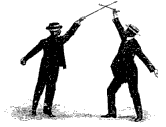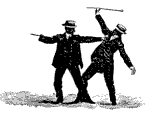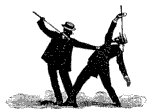
Tuesday, March the 28th, 2006
back to: title, date or indexes
One of the more outlandish episodes in Blodgett's frankly debauched life was the time he opened a dancing school, or, to give it its correct title, Doctor Blodgett's Terpsichorean Academy For Keen Young Chaps. It goes without saying that the rascal was not a doctor of any kind. Nor, it must be said, did he have any skills as a dancer, short of flinging himself around a room, knees and elbows akimbo, like some ungainly puppet whose handler is having convulsions.
Any keen young chap who enrolled in the Academy hoping to learn how to disport himself with aplomb in a quadrille, foxtrot or even the mashed potato, was quickly disillusioned. “Doctor” Blodgett's musical tastes were narrow and intense. He was a devotee of a particularly rigorous form of Teutonic improvisation, open-ended pieces that often lasted for hours on end, performed by earnest young men with incipient beards whose brows furrowed as they tinkered with deliberately out of tune violas, trombones, bells, and thunderous pounding drums. Blodgett devised his own dances to this screeching racket, the most notorious of which was called, for no apparent reason, the Mustard Plaster.
As luck would have it, a record of Blodgett's instructions for this dance survived the inferno which laid waste the Academy just a month after it opened. Blodgett, of course, vanished as soon as he got his hands on the insurance money, and as far as we know never taught dance again. Thus what is presented here is a piece of history that could so easily have been lost forever. But now you too can learn how to “Do The Mustard Plaster!”, by following the notes written by Blodgett himself.

Figure One. Let us call the dancers Basil (left) and Guido (right). They take up positions facing each other as shown, pointing with their sticks. Basil's stick is cut from a sycamore tree, and has traces of birdlime upon it. Guido's is made of plastic. The symbolism is clear. They maintain this stance, staring fixedly at each other, until I snap my fingers.

Figure Two. Basil raises his stick, upwards and forwards. Guido essays a series of twirls, jumps, and hops, and crashes his body as hard and as fast as possible into all four walls of the studio. If his hat falls off, he must replace it in a single, fluid motion, full of elegance and grace. He then takes a flying leap to return to his starting point, and raises his plastic stick to meet Basil's.

Figure Three. It is now Basil's turn to jump about and hurl himself at the walls, while Guido stands absolutely still with his stick above his head. Basil should flounce, however, rather than trying to emulate Guido's more frenetic movements. He should nudge the walls rather than buffet them, and sashay back to his starting position with an air of insouciance. When he is once again opposite Guido, he punches him in the throat.

Figure Four. To the insistent clanging of bells, Guido leans backwards, balancing his stick on his forehead. Basil takes hold of his necktie, but not tightly. They rotate a full 360 degrees, pretending to be figurines in a decorative snow-shaker. This takes consummate skill, and the difficulty of teaching this movement explains the supplementary fee tacked on to the standard cost of this lesson, to be paid in cash.

Figure Five. Having completed a full rotation, Basil adopts a heroic pose while Guido splays himself on the floor. At a snap of my fingers, Basil crumples and Guido gets up, shimmies, vaults over Basil, and in rapid succession essays a quadrille, foxtrot, and mashed potato solo. Basil gets to his feet. They throw their sticks out of an open window, and clutch each other like lovers on a hilltop during a thunderstorm. A parp from the trombone brings the dance to an end.
Hooting Yard on the Air, June the 30th, 2011 : “Hudson's Head Revisited” (starts around 23:30)
Hooting Yard on the Air, March the 24th, 2016 : “Fear Eats the Soul” (starts around 13:20)